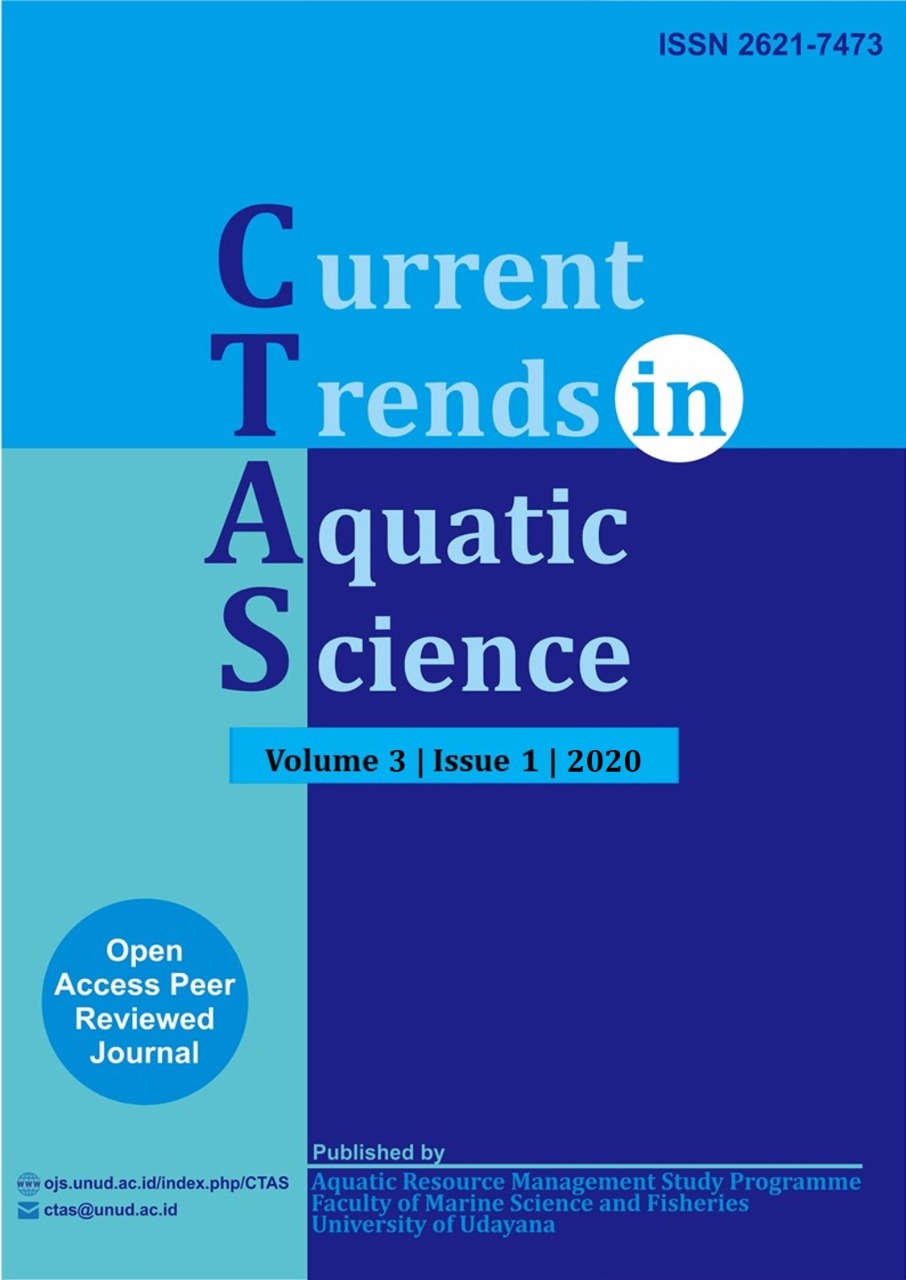Analisis Kandungan Karbon, Nitrogen Dan Jumlah Total Bakteri Pada Substrat Dasar Tambak Udang Vannamei (Litopenaeus vannamei) Pada Pertengahan Masa Tanam Di Desa Sanggalangit, Gerokgak, Buleleng, Bali.
Analysis of Carbon, Nitrogen Content and Total Bacteria in the Base Substrate of Vannamei Shrimp (Litopenaeus vannamei) Ponds in the Middle of the Planting Period in Sanggalangit Village, Gerokgak, Buleleng, Bali.
Abstract
This study aims to determine the content of organic carbon, total nitrogen (TN), the total number of bacteria (TB) and the level of decomposition of organic matter in the bottom substrate of shrimp vannamei ponds (Litopenaeus vannamei) in Sanggalangit Village, Gerokgak District, Buleleng, Bali. Organic matter that is constantly accumulating on the pond bottom substrate can reduce the quality of the water. Data was collected in February-May 2019 using purposive sampling method with the number of ponds studied as many as 9 ponds. This research uses quantitative descriptive methods. Measurement of total nitrogen is done using the Indophenol method, organic carbon using the Walkley and Black method and total bacteria using the TPC (Total Plate Count) method. The results of this study obtained an average value of 29.34% organic carbon content, 1.15% total nitrogen and 15.2×106 total bacteria. The level of decomposition of organic matter in vannamei shrimp ponds (Litopenaeus vannamei) in Sanggalangit Village was included in the balanced category (C/N = 29.37). The measured C/N ratio indicates that the decomposition process of organic matter is going well so that the exchange of nutrients from the substrate to the pond water media is going well in supporting the pond productivity.
Downloads
References
Arikunto, S. (2013). Prosedur Penelitian, Suatu Pendeketan Praktik. Jakarta: Rineka Cipta
Awanis, S., Schlegelmilch, B. B., & Cui, C. C. (2017). Asia’s materialists: Reconciling collectivism and materialism. Journal of International Business Studies, 48(8): 964-991
Badan Standardisasi Nasional. (2013). Cara Uji Kadar Nitrogen Total Sedimen dengan Distilasi Kjeldahl secara Titrasi (SNI 4146:2013). Jakarta.
Budiardi T. (1998). Evaluasi akumulasi bahan organic, penyiponan dan produksi udang windu (Penaeus monodon) pada budidaya intensif. Tesis. Bogor, Indonesia: Program studi Magister Sains, Program Pascasarjana Institut Pertanian Bogor. 63 hal.
Brune, D. E., Schwartz, G., Eversole, A. G., Collier, J. A., & Schwedler, T. E. (2003). Intensification of pond aquaculture and high rate photosynthetic systems. Aquacultural engineering, 28(1-2), 65-86.
Ebeling, J. M., Timmons, M. B., & Bisogni, J. J. (2006). Engineering Analysis of The Stoichiometry of Photoautotrophic, Autotrophic, and Heterotrophic Removal Of Ammonia–Nitrogen In Aquaculture Systems. Aquaculture, 257(1-4), 346-358.
Effendi, H. (2003). Telaah Kualitas Air Bagi Pengelolaan Sumberdaya dan Lingkungan Perairan. Yogyakarta: Kanisius. 57-192 hlm.
Ekasari, J. (2009). Bioflocs technology: the effect of different carbon source, salinity and the addition of probiotics on the primary nutritional value of the bioflocs. Thesis. Faculty of Bioscience Engineering. Ghent University. Belgium
Fauzi, A. (2008). Analisa Kadar Unsur Hara Karbon Organik dan Nitrogen di Dalam Tanah Perkebunan Kelapa Sawit Bengkalis Riau. Amd. TA. Universitas Sumatera Utara, Medan.
Foth, H. D. 1979. Dasar-Dasar Ilmu Tanah. Erlangga. Jakarta, Indonesia.
Ghufran, M dan A, Baso. (2007). Pengelolaan Kualitas Air dalam Budidaya Perairan. Rineka Cipta. Jakarta. 200 hlm.
Hastuti P. Y. (2011). Nitrifikasi dan Denitrifikasi di Tambak. Jurnal Akuakultur Indonesia. 10 (1): 89-98
Kennish, M. J. (2002). Environmental threats and environmental future of estuaries. Environmental conservation, 29(1), 78-107.
Madenjian, C. P. (1990). Patterns of Oxygen Production and Consumption In Intensively Managed Marine Shrimp Ponds. Aquaculture Research, 21(4), 407-417.
Maswardi, A., E. Sutikno, dan D. Adiwijaya. (2003). Usaha budidaya tambak dan pembenihan terpadu. Departemen Kelautan dan Perikanan. Direktorat Jenderal Perikanan Budidaya. Balai Besar Pengembangan Budidaya Air Payau. Jepara. 16hlm.
Meagaung, W. D. M. (2000). Karakterisasi dan pengelolaan residu bahan organik pada dasar tambak udang intensif Disertasi. Makassar. Program Pascasarjana Universitas Hasanuddin. 128hlm.
Notohadiprawiro, T. (1998). Tanah dan lingkungan. Direktorat Jenderal Pendidikan Tinggi, Departemen Pendidikan dan Kebudayaan. Jakarta. 237hlm.
Stickey, R, R. (2005). Aquaculture: An Introductory text. CABI. USA: Publishing. 256p.
Sugiyono, (2009). Metode Penelitian Pendidikan Pendekatan Kuantitatif, Kualitatif dan R&D. Bandung: Alfabeta.
Suprapto, N., Chang, T. S., & Ku, C. H. (2017). Conception of learning physics and self-efficacy among Indonesian university students. Journal of Baltic Science Education, 16(1), 7-19.
Suwono, S. H. (2015). Limbah sedimen tambak udang vaname (Litopenaeus vannamei) super intensif dengan kepadatan berbeda. Dalam Prosiding Forum Inovasi Akuakultur. Sulawesi selatan Indonesia. 2015. Hlm 901-913.
Vrananta D. S., Prijadi S, & Norma A. (2013). Hubungan Nisbah C/N Dengan Jumlah Total Bakteri pada Sedimen Tambak di Areal Balai Besar Pengambangan Budidaya Air Payau, Jepara. Journal of Management of Aquatic Resources. 2(3), 265-272.
Wijayanti, R., & Budi, P. (2018). Pengaruh Pemberian Urea Terhadap Laju Dekomposisi Serasah Tebu Di Pusat Penelitian Gula Jengkol, Kabupaten Kediri, Jurnal Tanah dan Sumberdaya Lahan, 5(1), 793-799


